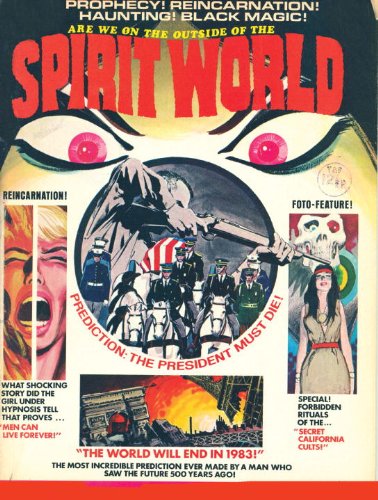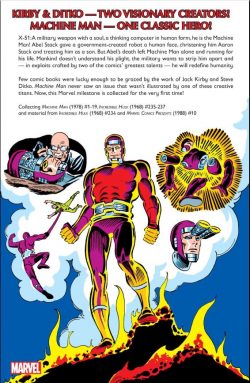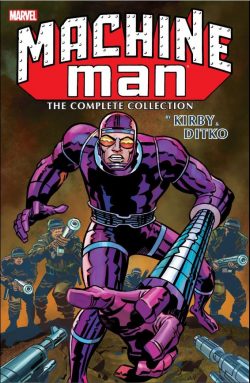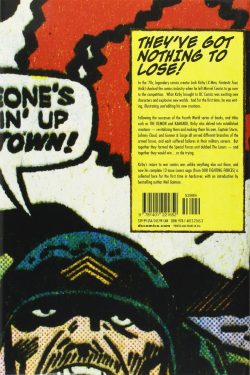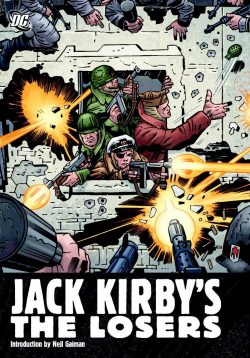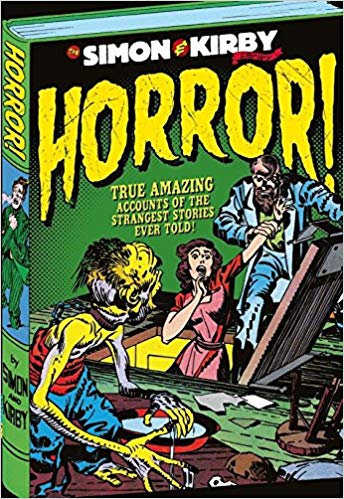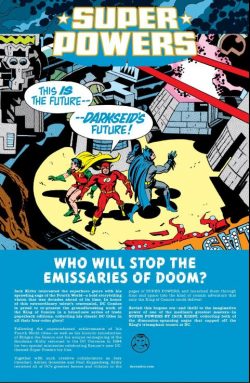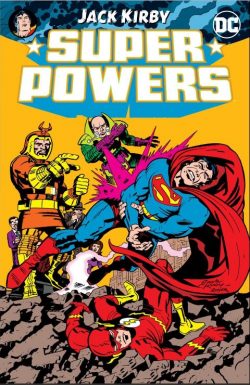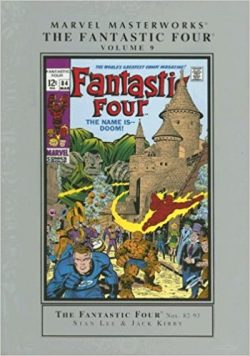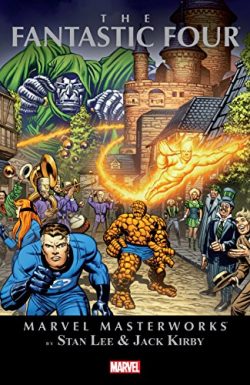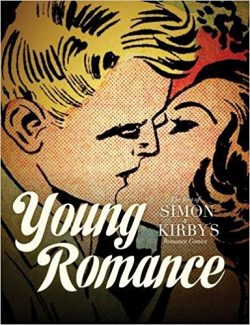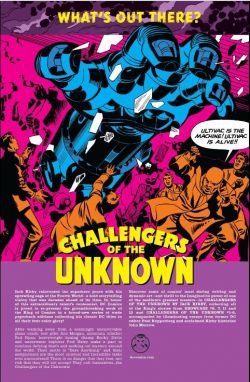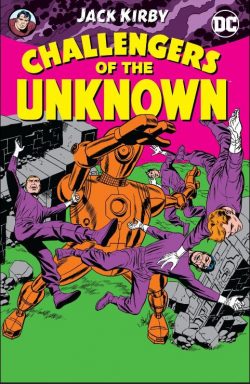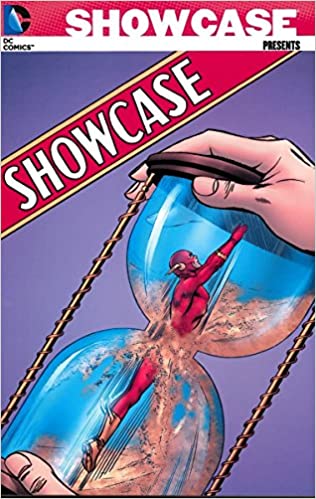
By Many and various (DC Comics)
ISBN: 978-1-78116-364-1 (TPB)
If you’re a book reviewer, Christmas often comes incredibly early. We received lots and lots of lovely new tomes in the last week and I’ve still not caught up yet, so in the meantime, I’m fobbing you all off with a reworked recommendation I was saving for our actual Christmas promotion season. It’s still a wonderful read criminally in need of re-release and a digital edition, but readily available – for now…
The review is incredibly long. If you want to skip it and just buy the book – because it’s truly brilliant – then please do. I won’t mind and you won’t regret it at all…
In almost every conceivable way, DC’s original “try-out title†Showcase created and dictated the form of the Silver Age of American comic books and is responsible for the multi-billion-dollar industry and art form we all enjoy today.
For many of us old lags, the Silver Age is the ideal era and a still-calling Promised Land of fun and thrills. Varnished by nostalgia (because it’s the era when most of us caught this crazy childhood bug), the clean-cut, unsophisticated optimism of the late 1950s and early 1960s produced captivating heroes and compelling villains who were still far less terrifying than the Cold War baddies then troubling the grown-ups. The sheer talent and unbridled professionalism of the creators working in that too-briefly revitalised comics world resulted in triumph after triumph and even inspired competitors to step up and excel: all of which brightened our young lives and still glow today with quality and achievement.
The principle was a sound one and graphically depicted in the very first issue: the Editors at National/DC were apparently bombarded with readers’ suggestions for new titles and concepts and the only possible way to feasibly prove which would be popular was to offer test runs and assess fan reactions – for which read Sales…
Firmly ensconced in the age of genre thrillers and human adventurers, this magnificent, monolithic monochrome tome covers the first 21 issues from that historic series, spanning March/April 1956 to July/August 1959, and starts the ball rolling with the first and last appearances of Fireman Farrell in a proposed series dubbed Fire Fighters.
Following the aforementioned short ‘The Story Behind Showcase’ by Jack Schiff & Win Mortimer, the human-scaled dramas begin in ‘The School for Smoke-Eaters’ by Schiff and the superb John Prentice (Rip Kirby), introducing trainee fireman Mike Farrell during the last days of his training and desperate to simultaneously live up to and escape his father’s fabulous record as a legendary “smoke-eaterâ€.
The remaining stories, both scripted by Arnold Drake, deal with the job’s daily dilemmas: firstly in ‘Fire under the Big Top’ wherein an unscrupulous showman ignored Farrell’s Fire Inspection findings with tragic consequences, and in‘Fourth Alarm’ mixing an industrial dispute over fireman’s pay, a crooked factory owner and a waterfront blaze captured on live TV in a blisteringly authentic tale of human heroism.
Showcase #2 featured Kings of the Wild: tales of animal valour imaginatively related in three tales scripted by Robert Kanigher – who had thrived after the demise of superheroes with a range of fantastical genre adventures covering western, war, espionage and straight adventure. Stunningly illustrated by Joe Kubert, ‘Rider of the Winds’ tells of a Native American lad’s relationship with his totem spirit Eagle; ‘Outcast Heroes’ (Ross Andru & Mike Esposito) relates how an orphan boy’s loneliness ends after befriending a runaway mutt who eventually saves the town’s kids from a flood before ‘Runaway Bear’ – drawn by Russ Heath – uses broad comedy to describe how an escaped circus bruin battles all the horrors of the wilderness to get return to his comfortable, safe life under the Big Top.
Issue #3 debuted Kanigher & Heath’s The Frogmen in an extended single tale following candidates for a US Underwater Demolitions Team as they move from students to successful undersea warriors. Beginning with ‘The Making of a Frogman’ as the smallest diver – mocked and chided as a ‘Sardine’ by his fellows (especially ‘Shark’ and ‘Whale’) – perseveres and forges bonds until the trio are dumped into blazing Pacific action in ‘Flying Frogmen’, learning the worth of teamwork and sacrifice by destroying a Japanese Sub base in ‘Silent War’…
The feature returned as a semi-regular strip in All-American Men of War #44 (April #1957) amongst other Kanigher-edited war comics: making Frogmen the first but certainly not the last graduate of the try-out system. The next debut was to be the most successful but the cautious publishers took a long, long time to make it so…
No matter which way you look at it, the Silver Age officially arrived began with The Flash. It’s an unjust but true fact that being first is not enough; it also helps to be best and people have to notice. The Shield beat Captain America to the news-stands by over a year yet the former is all but forgotten today.
The industry had never really stopped trying to revive superheroes when Showcase #4 was released in late summer of 1956, with such precursors as The Avenger (February-September 1955); Captain Flash (November 1954-July 1955); Marvel’s Human Torch, Sub-Mariner and aforementioned Sentinel of Liberty (December 1953-October 1955) and even DC’s own Captain Comet (December 1953-October 1955) and Manhunter from Mars (November 1955 until the close of the 1960’s and almost the end of superheroes again!) still turning up in second-hand-stores and “Five-and-Dime†bargain bins. What made the new Fastest Man Alive stand out and stick was … well, everything!
Once DC’s powers-that-be decided to try superheroes once more, they moved pretty fast themselves. Editor Julie Schwartz asked office partner and Golden-Age Flash scripter Kanigher to recreate a speedster for the Space Age, aided and abetted by Carmine Infantino & Joe Kubert, who had also worked on the previous incarnation.
The new Flash was Barry Allen, a forensic scientist simultaneously struck by lightning and bathed in the exploding chemicals of his lab. Supercharged by the accident, Barry took his superhero identity from a comic book featuring his predecessor (scientist Jay Garrick, who was exposed to the mutagenic fumes of “Hard Waterâ€). Designing a sleek, streamlined bodysuit (courtesy of Infantino – a major talent rapidly approaching his artistic and creative pinnacle), Barry Allen became the point man for the spectacular revival of a genre and the entire industry.
‘Mystery of the Human Thunderbolt’ (Kanigher) and ‘The Man Who Broke the Time Barrier’ (written by the superb John Broome) are polished, coolly sophisticated stories introducing the comfortingly suburban superhero and establishing the broad parameters of his universe. Whether defeating bizarre criminal masterminds such as The Turtle or returning criminal exile Mazdan to his own century, the new Flash was a protagonist of keen insight and sharp wits as well as overwhelming power. Nonetheless the concept was so controversial that despite phenomenal sales, rather than his own series the Fastest Man Alive was given a Showcase encore almost a year later…
Showcase #5 featured the last comics concept in years that didn’t actually develop into an ongoing series, but that’s certainly due to changing fashions of the times and not the quality of the work. The three crime yarns comprising cops-&-robbers anthology Manhunters, begin with ‘The Greatest Villain of all Time’ by Jack Miller & Mort Meskin, revealing how Hollywood screenwriter-turned-police detective Lt. Fowler is dogged by a madman playing for real all the fantastic bad guys the mystery author had once created, whilst ‘The Two Faces of Mr. X’ (Miller, Curt Swan & Sy Barry) finds a male model drafted by the FBI to replace a prominent mob-boss. Unfortunately, it’s the day before the gangster is scheduled for face-changing plastic surgery…
‘The Human Eel’ (Miller & Bill Ely) then pits a cop unable to endure heights against an international high-tech rogue who thinks he hold all the winning cards…
The next try-out was on far firmer fashion grounds and was the first feature to win two issues in a row.
The Challengers of the Unknown were a bridging concept. As the superhero genre was ever so cautiously alpha-tested in 1956 here was a super-team – the first new group-entry of this still-to-be codified era – but with no uncanny abilities or masks, the most basic and utilitarian of costumes, and the most dubious of motives: Suicide by Mystery…
If you wanted to play editorially safe you could argue that were simply another para-military band of adventurers like the long running Blackhawks… but they weren’t.
A huge early hit – winning their own title before The Flash (March 1959) and just two months after Lois Lane (March 1958, although she had been a star in comics since 1938 and even had TV, radio and movie recognition on her side) – the Challs struck a chord resonating for more than a decade before they finally died… only to rise again and yet again. The idea of them was stirring enough, but their initial execution made their success all but inevitable.
Jack Kirby was – and remains – the most important single influence in the history of American comics. There are quite rightly millions of words written about what the man has done and meant, and you should read those if you are at all interested in our medium. When the comic industry suffered a collapse in the mid 1950’s, Kirby briefly returned to DC, crafting genre mystery tales and revitalising the Green Arrow back-up strip whilst creating newspaper strip Sky Masters of the Space Force. He also re-packaged for Showcase an original super-team concept that had been kicking around in his head since he and long-time collaborator Joe Simon had closed their innovative but unfortunate Mainline Comics.
The Challengers of the Unknown were four extraordinary mortals; heroic adventurers and explorers brought together for a radio show who walked away unscathed from a terrible plane crash. Already obviously what we now call “adrenaline junkiesâ€, they decided that since they were all living on borrowed time, they would dedicate what remained of their lives to testing themselves and fate. They would risk their lives for Knowledge and, of course, Justice.
Showcase #6, dated January/February 1957 – which meant it came out in time for Christmas 1956 – introduced pilot Ace Morgan, wrestler Rocky Davis, acrobat Red Ryan and scholarly marine explorer “Prof†Haley in a no-nonsense romp by Kirby, scripter Dave Wood, inkers Marvin Stein and Jack’s wife Roz, before devoting the rest of the issue to a spectacular epic with the doom-chasers hired by duplicitous magician Morelian to open an ancient casque holding otherworldly secrets and powers in ‘The Secrets of the Sorcerer’s Box!’
This story roars along with all the tension and wonder of the B-movie thrillers it emulates, and Kirby’s awesome drawing resonates with power and dynamism as the heroes tackle ancient horrors such as ‘Dragon Seed!’, ‘The Freezing Sun!’ and ‘The Whirling Weaver!’
The fantasy magic continued in the sequel: a science fiction crisis caused when an alliance of Nazi technologies with American criminality unleashes a robotic monster. Scripted by Kirby, ‘Ultivac is Loose!’ (Showcase #7, March/April 1957) introduces quietly capable boffin Dr. June Robbins, who becomes the fifth Challenger at a time when most comic females had returned to a subsidiary status in that so-conservative era.
As her computers predict ‘A Challenger Must Die!’, the lads nevertheless continue to hunt a telepathic, sentient super-robot who inadvertently terrorises ‘The Fearful Millions’ but soon find their sympathies with the tragic artificial intelligence after ‘The Fateful Prediction!’ is fulfilled…
Showcase #8 (June 1957) again featured the Flash, leading with another Kanigher tale – ‘The Secret of the Empty Box’. This perplexing but pedestrian mystery sees Frank Giacoia debut as inker, but the real landmark is Broome’s thriller ‘The Coldest Man on Earth’. With this yarn the author confirmed and consolidated the new phenomenon by introducing the first of a Rogues Gallery of outlandish super-villains. Unlike Golden Age stalwarts, new super-heroes would face predominantly costumed foes rather than thugs and spies. Henceforth, Bad Guys would be as visually arresting and memorable as the champions of justice. Captain Cold would return time and again as pre-eminent Flash Foe and Broome would go on to create every single member of Flash’s classic pantheon of super-villains.
Also included is filler reprint ‘The Race of Wheel and Keel’ by Gardner Fox, Gil Kane & Harry Lazarus, from All-Star Comics #53 (June/July 1950): a true story of how in 1858 a shipping magnate and stagecoach tycoon competed to prove which method of transportation was fastest…
When Lois Lane – arguably the oldest supporting character/star in the Superman mythology if not DC universe – finally received her own shot at a solo title, it was very much on the terms of the times.
I must shamefacedly admit to a deep, nostalgic affection for her bright, breezy, fantastically fun adventures, but as a free-thinking, (nominally) adult liberal of the 21st century I’m astounded now at the jolly, patronising, patriarchally misogynistic attitudes underpinning so many of the stories.
Yes, I’m fully aware that the series was intended for young readers at a time when “dizzy dames†like Lucille Ball or Doris Day played to a popular American stereotype of Woman as jealous minx, silly goose, diffident wife and brood-hungry nester, but asking kids to seriously accept that intelligent, courageous, ambitious, ethical and highly capable females would drop everything they’d worked hard for to lie, cheat, inveigle, manipulate and entrap a man just so that they could cook pot-roast and change super-diapers is just plain crazy and tantamount to child abuse.
I’m just saying…
Showcase #9 (cover-dated July/August 1957) featured Superman’s Girl Friend Lois Lane in three tales by Jerry Coleman, Ruben Moreira & Al Plastino; opening with seminal yarn ‘The Girl in Superman’s Past’ wherein Lois first meets red-headed hussy Lana Lang. The childhood sweetheart of Superboy seems to be a pushy conniving go-getter out to win Lois’ intended at all costs. Naturally Miss Lane invites Miss Lang to stay at her apartment and the grand rivalry is off and running…
‘The New Lois Lane’ aggravatingly saw Lois turn over a new leaf and stop attempting to uncover his secret identity just when Superman actually needs her to do so, and the premier concludes with concussion-induced day-dream ‘Mrs. Superman’ with Lois imagining a life of domestic super-bliss…
The next issue (September/October 1957) offered three more of the same, all illustrated by Wayne Boring & Stan Kaye, beginning with ‘The Jilting of Superman’ – scripted by Otto Binder – wherein the Man of Tomorrow almost falls for an ancient ploy as Lois pretends to marry another man to make the Kryptonian clod realise what she means to him…
‘The Sightless Lois Lane’ by Coleman reveals how a nuclear accident temporarily blinds the journalist, before her unexpected recovery almost exposes Clark Kent‘s secret when he callously changes to Superman in front of the blind girl. Binder delightfully closes the issue with ‘The Forbidden Box from Krypton’: a cache of devices dug up by a Smallville archaeologist originally packed by Jor-El to aid the infant superbaby on Earth. Of course, when Lois opens the chest all she sees is a way to become as powerful as the Man of Steel before becoming addicted to being a super-champion in her own right…
Superman’s Girlfriend Lois Lane launched into her own title scant months later, clearly exactly what the readers wanted…
Showcase #11 (November/December 1957) saw the Challengers return to combat an alien invasion on ‘The Day the Earth Blew Up’, with unique realist Bruno Premiani inking a taut doomsday chiller that keeps readers on the edge of their seats even today. Whilst searching for missing Antarctic explorers the Challs discover an under-ice base where double-brained aliens prepare to explosively alter the mass and gravity of Earth. Although intellectually superior, ‘The Tyrans’are no match for the indomitable human heroes and with their Plan A scotched, resort to brute force and ‘The Thing That Came out of the Sea’, even as Prof scuttles their aquatic ace in the hole with ‘One Minute to Doom’…
By the time of their final Showcase cases (#12, January/February 1958) they had already secured their own title. Here, though, ‘The Menace of the Ancient Vials’ is defused by the usual blend of daredevil heroics and ingenuity (with the wonderful inking of George Klein, not Wally Wood as credited here) as international spy and criminal Karnak steals a clutch of ancient chemical weapons which create giants and ‘The Fire Being!’, summon ‘The Demon from the Depths’and materialise ‘The Deadly Duplicates!’ before the pre-fantastic four put their enemy down.
Flash zipped back in Showcase #13 (March/April 1958) in a brace of tales pencilled by Infantino and inked by Joe Giella. Written by Kanigher, ‘Around the World in 80 Minutes’ follows the Scarlet Speedster as he tackles atomic blackmail in Paris, foils kidnappers and rebuilds a pyramid in Egypt; dismantles an avalanche in Tibet and scuttles a pirate submarine in the Pacific, before Broome’s ‘Master of the Elements’ introduces outlandish chemical criminal Al Desmond who ravages Central City as Mr. Element until the Flash outwits him.
One last try-out issue – inked by Giacoia – cemented the Flash’s future: Showcase #14 (May/June 1958) opens with Kanigher’s eerie ‘Giants of the Time-World!’ as the Fastest Man Alive smashes dimensional barriers to rescue his girlfriend Iris West from uncanny cosmic colossi and stamp out an alien invasion plan, after which Al Desmond returns with an altered M.O. and new identity. Doctor Alchemy‘s discovery of the mystic Philosopher’s Stone makes him ‘The Man who Changed the Earth!’: a stunning yarn and worthy effort to bow out on, but it was still nearly a year until the first issue of The Flash finally hit the stands.
To reiterate: Showcase was a try-out comic designed to launch new series and concepts with minimal commitment of publishing resources. If a new character sold well initially, a regular series would follow. The process had been proved with Frogmen, Lois Lane, Challengers of the Unknown and Flash, so Editorial Director Irwin Donenfeld now urged his two Showcase editors to create science fiction heroes to capitalise on the twin zeitgeists of the Space Race and the popular fascination with movie monsters and aliens. Jack Schiff came up with a “masked†crimefighter of the future – who featured in issues #15 and 16 – whilst Julie Schwartz concentrated on the now in the saga of a contemporary Earth explorer catapulted into the most uncharted territory yet imagined.
Showcase #15 (September/October 1958) commenced without fanfare – or origin – the ongoing adventures of Space Ranger – beginning in ‘The Great Plutonium Plot’ (plotted by Gardner Fox, scripted by pulp veteran Edmond Hamilton and illustrated by Bob Brown).
Their hero was in actuality Rick Starr, son of a wealthy interplanetary businessman who – thanks to incredible gadgets and the assistance of shape-shifting alien pal Cryll and capable Girl Friday Myra Mason – spent his free time battling evil and injustice. When Jarko the Jovian space pirate targets only ships carrying the trans-uranic element, Rick suspects a hidden motive. Donning his guise of the Space Ranger, he lays a cunning trap, exposing a hidden mastermind and a deadly ancient device endangering the entire solar system…
From his base in a hollow asteroid, Space Ranger ranges the universe and ‘The Robot Planet’ brings him and his team to Sirius after discovering a diabolical device designed to rip Sol’s planets out of their orbits. At the end of his voyage, Starr discovers a sublime civilisation reduced to cave-dwelling and a mighty computer intelligence intent on controlling the entire universe unless he can stop it…
Issue #16 opened with ‘The Secret of the Space Monster’ (plot by John Forte, scripted by Hamilton, illustrated by Brown) with Rick, Myra and Cryll investigating an impossible void creature and uncovering a band of alien revolutionaries testing novel super-weapons. ‘The Riddle of the Lost Race’ (Fox, Hamilton & Brown) then takes the team on a whistle-stop tour of the Solar system in pursuit of a vicious criminal and hidden treasures of a long-vanished civilisation.
A few months later Space Ranger was transported to science fiction anthology Tales of the Unexpected, beginning with issue #40 (August 1959) to hold the lead and cover spot for a 6-year run…
One of the most compelling and revered stars of those halcyon days was an ordinary Earthman who regularly travelled to another world for spectacular adventures, armed with nothing more than a ray-gun, a jetpack and his own ingenuity. His name was Adam Strange, and like so many of that era’s triumphs, he was the brainchild of Julius Schwartz and his close team of creative stars.
Showcase #17 (November/December 1958) proclaimed Adventures on Other Worlds, courtesy of Gardner Fox, Mike Sekowsky & Bernard Sachs, telling of an archaeologist who, whilst fleeing from enraged natives in Peru, jumps a 25-foot chasm only to be hit by a stray teleport beam from a planet orbiting Alpha Centauri. Rematerialising on another planet filled with giant plants and monsters, he is rescued by a beautiful woman named Alanna who teaches him her language via a cunning contrivance. ‘Secret of the Eternal City!’ reveals Rann is a world recovering from atomic war, and the beam Adam intercepted was in fact a simple flare, one of many sent in an attempt to communicate with other races.
In the four years (Speed of Light, right? As You Know, Bob – Alpha Centauri is about 4.3 light-years from Sol) the Zeta-Flare travelled through space, cosmic radiation converted it into a teleportation beam. Until the radiation drains from his body Strange is a most willing prisoner on a fantastic world of mystery, adventure and romance…
And an incredibly unlucky one apparently, as no sooner has Adam started acclimatising than an alien race The Eternalsinvades, seeking a mineral that grants them immortality. Strange’s courage and sharp wits enable him to defeat the invaders only to have the Zeta radiation finally fade, drawing him home before his adoring Alanna can administer a hero’s reward. Thus was established the principles of this beguiling series. Adam would intercept a Zeta-beam hoping for some time with his alien sweetheart, only to be confronted with a planet-menacing crisis.
The very next of these, ‘The Planet and the Pendulum’ sees him obtain the crimson-and-white spacesuit and weaponry that became his distinctive trademark in a tale of alien invaders attacking a lost colony of Rannians. They reside on planetary neighbour Anthorann – a fact that also introduces the major subplot of Rann’s still-warring city-states, all desperate to progress and all at different stages of recovery and development….
The next issue featured the self-explanatory ‘Invaders from the Atom Universe’ – with sub-atomic marauders displacing the native races until Adam unravels their nefarious plans – and ‘The Dozen Dooms of Adam Strange’, wherein our hero outfoxes the dictator of Dys who plans to invade Alanna’s home-city Rannagar.
With this last story, Sachs was replaced by Joe Giella as inker, although the former did ink Showcase #19’s stunning Gil Kane cover, (March/April 1959) which saw the unwieldy Adventures on Other Worlds title replaced with eponymous logo Adam Strange.
‘Challenge of the Star-Hunter’ and ‘Mystery of the Mental Menace’ are classic puzzle tales wherein the Earthman must outwit a shape-changing alien and an all-powerful energy-being. After so doing, Adam Strange took over the lead spot and cover of anthology comic Mystery in Space with the August issue.
Clearly on a creative high and riding a building wave, Showcase #20 (May/June 1959) introduced Rip Hunter… Time Master and his dauntless crew as ‘Prisoners of 100 Million BC’ (by Jack Miller & Ruben Moreira) in a novel-length introductory escapade seeing the daredevil physicist, his engineer friend Jeff Smith, girlfriend Bonnie Baxter and her little brother Corky travel to the Mesozoic era, unaware they are carrying two criminal stowaways.
Once there, the thugs hi-jack the Time Sphere, holding it hostage until the explorers help them stock up with rare and precious minerals. Reduced to the status of castaways, Rip and his team become ‘The Modern-Day Cavemen’, but when an erupting volcano provokes ‘The Great Beast Stampede’, our dauntless chrononauts finally turn the tables on their abductors…
Miller was always careful to use the best research available, but never afraid to blend historical fact with bold fantasy for Hunter’s escapades, and this volume concludes with an epic follow-up. Illustrated by Sekowsky & Joe Giella, ‘The Secret of the Lost Continent’ (Showcase #21, July/August, 1959,) has the Time Masters jump progressively further back in time in search of Atlantis. Starting with a dramatic meeting with Alexander the Great in 331 BCE, the explorers follow the trail back centuries to ‘The Forbidden Island’ of Aeaea in 700 BCE and uncover the secret of the witch Circe before finally reaching 14,000 BCE and ‘The Doomed Continent’ only to find the legendary pinnacle of early human achievement to be a colony of stranded extraterrestrial refugees…
Rip Hunter would appear twice more in Showcase before winning his own comic. The succeeding months would see the Silver Age truly kick into High Gear with classic launches coming thick and fast…
These stories from a uniquely influential comic book determined the course of the entire American strip culture and for that alone they should be cherished, but the fact they are still some of the most timeless, accessible and entertaining graphic adventures ever produced is a gift that should be celebrated by every fan and casual reader.
Buy this for yourself, get it for your friends and get a spare just because you can…
© 1956, 1957, 1958, 1959, 2012 DC Comics. All Rights Reserved.
